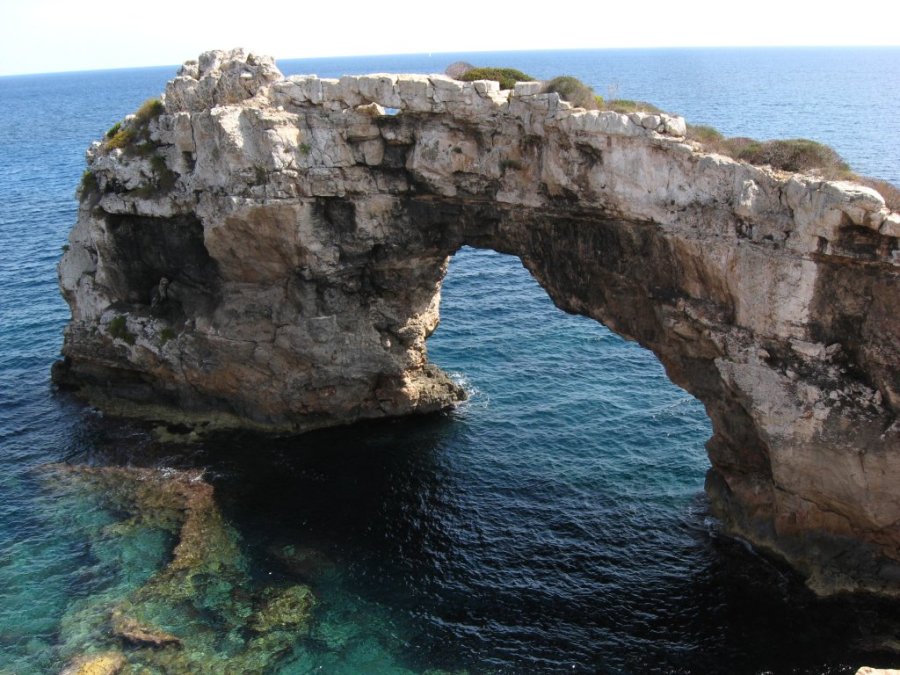Es Pontas

Awarded 07/25/2013
 |
English version (German version below): |
Es Pontas is a natural arch located at the southeastern part of Mallorca, Spain, one of the Balearic Islands. It can be easily reached from the small town of Santanyí by following the signs to Cala Santanyi and then signs to "Es Pontas".
A natural arch or natural bridge is a natural formation (or landform) where a rock arch forms, with a natural passageway through underneath. Most natural arches form as a narrow ridge, walled by cliffs, become narrower from erosion, with a softer rock stratum under the cliff-forming stratum gradually eroding out until the rock shelters thus formed meet underneath the ridge, thus forming the arch. Natural arches commonly form where cliffs are subject to erosion from the sea, rivers or weathering (sub-aerial processes); the processes "find" weaknesses in rocks and work on them, making them bigger until they break through.
The choice of "bridge" vs "arch" is somewhat arbitrary. The Natural Arch and Bridge Society identifies a bridge as a subtype of arch that is primarily water-formed. By contrast, the Dictionary of Geological Terms defines a natural bridge as a "natural arch that spans a valley of erosion."
On coasts this can form two different types of arches depending on the geology. On discordant coastlines rock types run at 90° to the coast. Wave refraction concentrates the wave energy on the headland, and an arch forms when caves break through the headland, e.g., London Bridge in (Victoria, Australia). When these eventually collapse, they form stacks and stumps. On concordant coastlines rock types run parallel to the coastline, with weak rock (such as shale) protected by stronger rock (such as limestone) the wave action breaks through the strong rock and then erodes the weak rock very quickly. Good examples of this are at Durdle Door and Stair Hole near Lulworth Cove on the Dorset Jurassic Coast in south England, although these are on an area of concordant coastline. When Stair Hole eventually collapses, it will form a cove.

Zum Vergrößern bitte Anklicken / click for enlargement
To log this earthcache, perform the following tasks:
- Go to N39° 19.560 E3° 08.655. There please take optional a photo of you in front of "Es Pontas". If you are there without any help, you can take a photo of your GPSr with readable coordinates instead.
- Estimate the height and width of the arch. Send your estimation to me!
 |
Deutsche Version: |
Es Pontas ist ein berühmtes Felsentor im süd-östlichen Teil der Insel Mallorca. Es kann sehr leicht erreicht werden über die Stadt "Santanyí". Folgt dort der Beschilderung nach "Cala Santanyi".
Felsentore sind brücken- oder fensterartig durchbrochene Gesteinsformationen, die durch Erosion entstehen. Je nach Größe, Form, Entstehung und Umgebung kommen andere Bezeichnungen zum Tragen, etwa Felsbrücke, Stein- oder Felsbogen, Naturbrücke oder Brandungstor. Ihre Öffnung ist vollständig von Gestein umgeben, und die Dicke der durchbrochenen Gesteinsformation ist von etwa gleicher Größenordnung wie die Breite und Höhe. Diese Erosionsformen gibt es in sehr unterschiedlichen Größen, vom kaum daumendicken Loch bis zu mehr als hundert Meter messenden Öffnungen, die von Felsen überwölbt sind.
Die genannten Erosionsformen können in allen Gesteinsarten entstehen. Sie sind kurzlebig in direkt erodierbaren Gesteinen oder in Umgebungen mit hoher Erosionsenergie, so etwa der Brandungszone von Steilküsten. Dauerhafte große Formen bilden sich besonders häufig in Sand- und Kalkstein, da diese widerständigen Gesteine für Lösung durch Wasser und Verwitterung anfällig sind.
Im englischen werden solche Erosionsformen Natural Arch oder Natural Bridge genannt. Nach der Einteilung der Natural Arch and Bridge Society entsteht ein Natural Arch ohne Beteiligung von fließendem Wasser. Solche Formen sind im Westen der USA häufig und entstehen dort hauptsächlich in Sandstein. Die Natural Bridge entsteht dagegen durch die Wirkung fließenden Wassers und wird in vielen Fällen ständig oder zeitweilig von einem Bach oder Fluss durchflossen. "Es Pontas" ist demnach ein Beispiel für eine Natural Bridge.

Zum Vergrößern bitte Anklicken / click for enlargement
Um diesen Earthcache zu loggen, erfülle bitte folgende Aufgaben:
- Gehe zu N39° 19.560 E3° 08.655. Mache hier bitte freiwillig ein Foto von Dir vor dem Felsentor. Falls du alleine bist, reicht auch ein Foto von deinem GPS mit lesbaren Koordinaten.
- Bestimme die Breite und Höhe von "Es Pontas". Sende Deine Schätzung per Mail.
